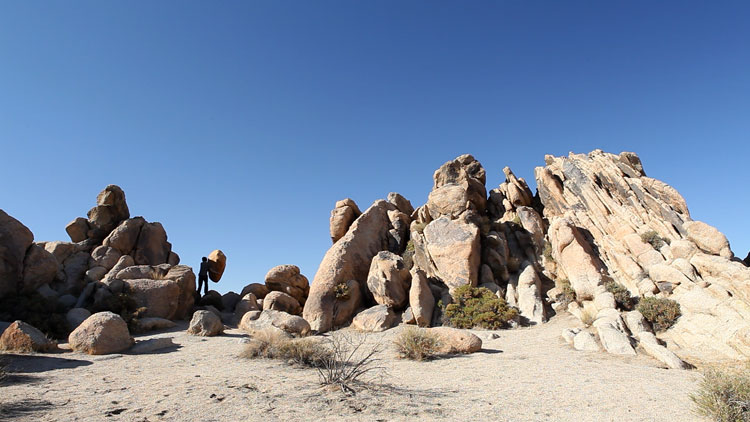I often feel the need to escape the insincerity of Los Angeles for the non-ironic nature of the desert. Hollywood’s slapstick tradition seems to have similar desires. A rock, maybe a bit browner than his companions, sits at the bottom of a boulder-pile. We watch the video—wind tapping the mic, sage swaying—for nearly 30 seconds thinking: This is one of the most boring Discovery channel shows I’ve ever seen and—did that rock just move? For the next 30-plus, somewhere between caterpillar and snail, the rock of Dong Hoon Jun’s Rock slithers into a more comfortable spot in the shade. Keep watching and the second part of the video has the artist emerge from another rock pile, hoist a hitherto multiple-ton boulder, and walk off with it. No minds would be blown if Buster Keaton entered frame, wondering where his rock disappeared to.
Dong Hoon Jun’s videos: office chairs spinning on their own, attempting to levitate, inch-worming across the floor, have a comic—as in Merry Melodies—aesthetic to them. The same with his photos: lots of the artist’s legs dangling from or emerging into places they don’t belong. Jun often uses quotidian spaces for his antics, recognizing, as the early slapstickers did, that this type of humor needs a straight man. Or straight location: the desert—harsh, barren, prickly.
The other side of Jun’s work, the fantastical of the everyday, also harmonizes in the location Hollywood has used for distant planets, or symbolic of unknown terrain. Jun, born in Seoul, Korea, uses this alien space to explore alienation. The movement of a rock alludes to migration and dislocation, Bugs Bunny hid behind a movable cactus to sneak past his gun-toting foe Elmer Fudd; Mexican immigrants, hidden in rocks, now must sneak through the desert past equally trigger-happy Texans.
In the photograph Rest, a man lies face down in the sand, seconds from the Pacific Ocean, footprints in the sand behind him. It’s a clever usurping of the man-looking-for-water-in-the-desert scenario used in New Yorker cartoons. Jun’s work of late is those desert views or overtly verdant, wet, landscapes. He’s captioned this series on his website “Dong sees america.” Like Buster Keaton jumping through dreams in Sherlock, Jr., it’s easy to edit these together and see the vaudevillian Jun picking up a rock from the desert sand in his video Rock, spooning with it in the photo series “Rock” and, attempting to find water, crawling West, and so close, finally passing out on the damp sand of the Pacific that laps the U.S. on one side and Asia on the other.


